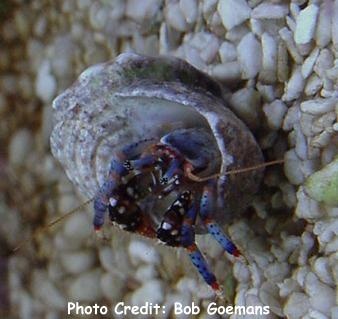
By Bob Goemans

Likely Reef Tank Suitable
Likely Fish-Only Tank Suitable
Range: Western Atlantic Ocean: Florida, Gulf of Mexico, and the Caribbean.
Size: 1 inch (2.5 cm)
Natural Environment: Inhabits rocky intertidal zones where they feed upon detritus and algae, and are more active during nighttime than daylight hours.
General Husbandry: Even though there are many small hermit crabs in the aquarium trade to choose from, this hardy species is especially popular with reef keepers. They are highly suitable for devouring unwanted algae growths, e.g., green hair algae and cyanobacteria, and do not damage corals. Nevertheless, their ability to climb upon almost anything in the aquarium, including corals, does disturb the corals, usually causing them to temporally close somewhat.
Stocking level recommendations vary greatly for these little janitors/scavengers, e.g., from 1 to 10 per gallon for reef aquariums. Yet one should relate their need to the condition of the aquarium, as very well maintained systems need only a few in the entire system. Overcrowded and/or overstocked systems no doubt need higher quantities. And new systems probably need none, as hermit nutritional needs will not be met until the aquarium ages somewhat.
In general, hermits can live for about 30 years in the wild, however, they don't last near that long in aquaria, with stays of about 1 - 2 years the average. Keep in mind even though most hermits are born in the water, when molting they seek the land and bury themselves for protection from predators. Depending on their age, the molting process can occur from once a month to once every 18 months, with the process taking about 10 days to complete. Therefore, their lifespan in aquaria is questionable/quite limited.
If the supply of algae is limited, an algae wafer or feeder block may help supplement their diet. They also feed on any uneaten foods that fall to the aquarium bottom, whether it's flake, frozen, or live.
Keep in mind they do not have a shell of their own and therefore seek suitable size empty shells for protection, usually empty snail shells. The tip of their abdomen is then backed into the columella of the empty shell, calling it home. When danger exists, they retract further into the shell, disappearing from view. As they grow larger via the molting process in the wild, they must seek other slightly larger empty shells. Its this process of living in someone else's shell that has led to their common name 'hermit,' i.e., a hermit living alone.
It's advisable to keep an assortment of different size empty snail shells in the aquarium when maintaining this species (or any hermit), as they are very fussy about the space they have inside their selected shell and are always looking for something better/slightly roomier! In fact, they often enter into battles with other hermits for their shells, with the loser either highly damaged or dead. They may also sometimes pick on live snails, however it is thought they are seeking the shell and not attacking the snail itself.
Keep in mind they cannot tolerate copper treatments, therefore if they are in the same aquarium where fish need to be medicated with copper, they must be removed.
Taxonomy:
Kingdom: Animalia
Phylum: Arthropoda
Class: Malacostraca
Subclass: Eumalacostraca
Order: Decapoda
Superfamily: Paguroidea
Family: Diogenidae
Genus: Clibanarius
FYI: Not fussy about water quality.
An algae wafer or feeder block may help supplement their diet.
Experience Level: Beginner
Diet: Omnivore/Algae and detritus
Temperament: Peaceful
Aquarium Environment: Reef or fish-only aquarium
Coral Safe: Yes
Fish Safe: Yes
Invertebrate Safe: Yes
Temperature Range: 68 - 81°F (20 - 27°C)
